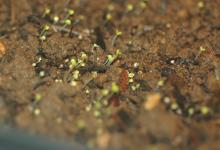Cause Both Pythium spp. and Rhizoctonia solani can cause pre- and post-emergence damping-off. Pythium is favored by cool and overly moist soil conditions.
Rhizoctonia survives in the soil as sclerotia or as mycelium colonizing bits of organic matter. Roots become infected as they grow past these structures. The fungus then grows along the root surface, forms an aggregation called an infection cushion, pushes into the root where it colonizes, spreads and kills the tissue. The fungus can form knots of mycelium that develop into sclerotia. These are released into the soil as the plant debris decomposes.
Symptoms Stems of seedlings or recent transplants collapse at the soil line and die. Cuttings may also rot. Rhizoctonia causes stems to become blackened and water-soaked.
Cultural control
- Plant in pasteurized, well-drained raised beds at the proper depth.
- Rotate to different beds from year to year.
- Avoid reusing pots or trays from a previous crop for propagation. If pots must be reused then wash off all debris and soak in a sanitizing solution or treat with aerated steam for 30 min.
- Let the soil dry down without drying out. Do not overwater.
- Media pH should be around 5.6 to 6.4 and note that coleus tend to naturally lower the growing media pH.
- Seeds should be planted when temperatures favor rapid germination and growth, so plants rapidly emerge and reach a more mature or hardened state. Use bottom heat when starting cuttings.
- Use as little misting as possible after sticking. Mist should not wet the media until roots are formed. Water cuttings after sticking and once on the bench. Maintain moderate media moisture while cuttings are forming callus. Start drying the media once callus has formed and reduce mist. Media should be light brown in color but not dry. Once roots form, dry media a little more but just enough to prevent wilting. Uniform moisture from top to bottom of media is important.
Chemical control for Pythium. Rotate fungicides that have a different mode of action for resistant management.
- Adorn at 1 to 4 fl oz/100 gal water plus another fungicide. Group 43 fungicide. 12-hr reentry.
- Banol at 2 to 3 fl oz/10 gal water. Group 28 fungicide. 12-hr reentry.
- Fosphite at 1 to 2 quarts/100 gal water. Do not use copper products within 20 days of treatment and do not use spray adjuvants. Group P7 fungicide. 4-hr reentry.
- Mefenoxam 2 AQ at 0.12 to 0.24 fl oz/100 gal water as a soil drench at seeding, at 0.49 to 0.98 fl oz/100 gal water at transplanting, and see label for media incorporation. Group 4 fungicide. No restrictions on reentry when used as a soil drench or media incorporation.
- Monterey Garden Phos at 1 teaspoon/8 gal water as a soil drench. Group P7 fungicide. H
- Subdue MAXX at 0.13 to 0.25 fl oz/100 gal water as a seeding drench. Group 4 fungicide. No restrictions on reentry when used as a soil drench.
- Terrazole 35 WP at 3.5 to 10 oz/100 gal water as a soil drench. Use only in commercial nurseries and greenhouses. Group 14 fungicide. 12-hr reentry.
Chemical control for Rhizoctonia
- Broadform at 2 to 8 fl oz/100 gal water. Group 7 + 11 fungicide. 12-hr reentry.
- Chipco 26019 FLO at 13 fl oz/100 gal water. Use 1 to 2 pints of this solution per sq ft. Group 2 fungicide. 12-hr reentry.
- Compass 50 WDG at 0.5 oz/100 gal water. Do not use organosilicate additives or more than two (2) consecutive applications. Group 11 fungicide. 12-hr reentry.
- Medallion WDG at 1 to 2 oz/100 gal water. Use with oils or adjuvants may damage plant. Group 12 fungicide. 12-hr reentry.
- Postiva at 10 to 28 fl oz/100 gal water as a drench. Group 3 + 7 fungicide. 12-hr reentry.
- Spirato GHN at 1 to 2 fl oz/100 gal water. Use with oils or adjuvants may cause plant damage. Group 12 fungicide. 12-hr reentry.
Reference Harlan, B.R., and Hausbeck, M.K. 2018. Diseases of Coleus. In McGovern, R.J. and Elmer, W.H. (eds.) Handbook of Florists' Crops Diseases. Springer Int.


